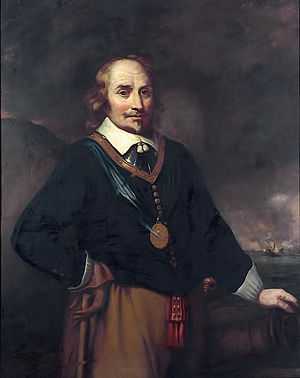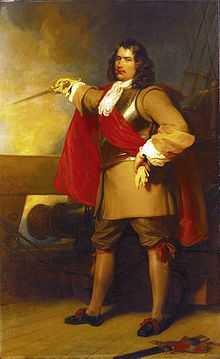Battle of Dungeness
The naval Battle of Dungeness took place on 30 November 1652 (10 December Gregorian calendar), [lower-alpha 1] during the First Anglo-Dutch War near the cape of Dungeness in Kent.
Background
In September 1652 the English government, mistakenly believing that the United Provinces after their defeat at the Battle of the Kentish Knock would desist from bringing out a fleet so late in the season, sent away ships to the Mediterranean. This left the English badly outnumbered in home waters. Meanwhile the Dutch were making every effort to reinforce their fleet.
Battle


On 21 November 1652 Lieutenant-Admiral Maarten Tromp, again (unofficial) supreme commander after his successor Vice-Admiral Witte de With had suffered a breakdown because of his defeat at the Battle of the Kentish Knock, set sail from Hellevoetsluis with 88 men of war and 5 fireships, escorting a vast convoy bound for the Indies. With the convoy safely delivered through the Straits of Dover, Tromp turned in search of the English, and on 29 November 1652 he encountered the English fleet of 42 ships commanded by General at Sea Robert Blake. The English promptly left their anchorage in the Downs, either because Blake did not realize how large the Dutch fleet was, or he did not want to become trapped like the Spanish had some years earlier in the Battle of the Downs. The wind was now strong from the north-west, so the English could not return to the Downs in either case, having to settle for Dover. Next morning, the two fleets moved south-west, with the English hugging the coast and the Dutch unable to engage until the curve of the shoreline forced the English to turn on a southerly course. At about 15:00, near the cape of Dungeness, the leading ships of both fleets met in a "bounteous rhetoric of powder and bullet" (according to a contemporary account).
The wind prevented a large part of the Dutch fleet from engaging Blake, whose fleet by nightfall had lost five ships of which the Dutch captured two, and damaged many more. The Dutch lost one ship through fire. Blake retreated under cover of darkness to his anchorage in the Downs. Tromp could not be satisfied with the result however as the Dutch had missed an opportunity to annihilate the English.[1]
Aftermath
The battle resulted in several reforms in the English Fleet. Part of Blake's force consisted of impressed merchant vessels that retained their civilian captains/owners. Many of them refused to participate in the battle. Some naval captains insisted on their traditional right to enter and leave the battle at times of their choosing, and to leave formation in order to secure any prize. Blake threatened to resign if something was not done. The Lords Commissioners of the Admiralty responded by:
- requiring all impressed vessels to be under the command of naval captains;
- dividing the fleet into squadrons under junior flag officers for better command and control;
- issuing Sailing and Fighting Instructions which significantly enhanced an admiral's authority over his fleet.[2]
The victory gave the Dutch temporary control of the English Channel and so control of merchant shipping. A legend says that Tromp attached a broom to his mast as a sign that he had swept the sea clean of his enemies, but in his book The Command of the Ocean, N.A.M. Roger doubts the legend as such a boasting action would have been out of character for Tromp. Additionally, at the time, a broom attached to a mast was the way of showing that a ship was for sale.
Also Dutch contemporaneous sources make no mention of it. The battle not only showed the folly of dividing forces while the Dutch still possessed a large fleet in home waters, but exposed "much baseness of spirit, not among the merchantmen only, but many of the state's ships". It seemed that the captains of hired merchant ships were reluctant to risk their vessels in combat, while the state's ships lacked the men to sail and fight them.
Ships
England (Blake)
- Triumph 60 (flag)
- Victory 60 (Lionel Lane)
- Vanguard 58 (John Mildmay)
- Fairfax[lower-alpha 2] 56 (John Lawson)
- Speaker[lower-alpha 2] 54 (John Gilson)
- Laurel 50 (John Taylor)
- Worcester 44 (Anthony Young)
- Garland 44 (Robert Batten) - Captured
- Entrance 43 (Edmund Chapman)
- Lion 42 (Charles Saltonsall)
- Convertine 42
- Foresight 42
- Dragon 40
- Fortune 36
- Hound 35
- Sapphire 34
- Princess Maria 33
- Mary flyboat 32
- Waterhound 30
- Dolphin[lower-alpha 2] 30 (William Badiley)
- Advantage 26 (William Beck)
- Swan[lower-alpha 2] 22
- Greyhound[lower-alpha 2] 20
- Hannibal[lower-alpha 2] 44 (Francis Barham)
- Anthony Bonaventure 36 (Walter Hoxon) - Captured
- Lisbon Merchant 34
- Loyalty[lower-alpha 2] 34
- Culpepper 30
- Cullen 28
- Prudent Mary 26
- Samuel 26
- Martha 25
- Katherine[lower-alpha 2] 24
- Exchange 24
- Acorn 22
The Netherlands (Tromp)
Tromp squadron
- Brederode 56 (flag, Admiralty of the Maze)
- Vrede 44, (flag of acting Vice-Admiral Gideon de Wildt, Admiralty of Amsterdam)
- Campen 40 (A)
- Wapen van Holland 39 (M)
- Prins 38 (flag of Rear-Admiral Corstiaen Corstiaenszoon de Munnick, Rotterdam Directors)
- Groote Liefde 38 (Amsterdam Directors)
- Engel Gabriel 36 (A)
- Burgh 34 (AD)
- Gideon 34 (AD)
- Hollandia 32 (A)
- Hoorn 32 (Admiralty of the Northern Quarter)
- Rotterdam 30 (M)
- Amsterdam 30 (A)
- Sint Pieter 28 (RD)
- Star 28 (A)
- Gouda 28 (A)
- Vergulde Pelicaen 28 (Harlingen Directors)
- Sint Maria 28 (AD)
- Hollandia 26 (RD)
De Ruyter squadron
- Vrijheid 46 (Amsterdam, flag of acting Vice-Admiral Augustijn Balck)
- Witte Lam 38 (Admiralty of Zealand, flag of Commodore Michiel de Ruyter, acting squadron commander replacing Vice-Admiral Witte de With)
- Sint Mattheeus 34 (AD)
- Croon Imperiael 34 (AD)
- Meerman 32 (RD)
- Zeelandia 32 (A)
- Schiedam (= Gelderland) 30 (R)
- Graaf Hendrick 30 (F)
- Leyden 28 (A)
- Achilles 28 (A)
- Arke Troyane 28 (AD)
- Frisia 28 (F)
- Breda 28 (F)
- Sphera Mundi 26 (R)
- Gulden Beer 24 (R)
- Overijssel 22 (R)
Evertsen squadron
- Hollandia 38 (Zealand Admiralty, flag of Vice-Admiral Johan Evertsen, flag captain Adriaan Banckert)
- Wapen van Veere 38 (Veeren Directors)
- Princes Louise 36 (acting Vice-Admiral Johan de Liefde, former flag of De With)
- Gulden Haen 36 (Middelburg Directors)
- Wapen van Zierikzee 34 (Zierikzee Directors)
- Faam 30 (Z)
- Gouden Leeuw 30 (MD)
- Gouden Leeuwin 30 (MD)
- Haes 30 (Flushing Directors)
- Zeeuwsche Leeuw 28 (Zealand Admiralty, flag of Commodore Cornelis Evertsen the Elder)
- Zeeridder 28 (Z)
- Neptunus 28 (Z)
- West Capelle 28 (Zealand Admiralty, captain Cornelis Evertsen the Younger)
- Goes 26 (Z)
- Liefde 26 (Z)
- Eendraght 24 (Z)
- Sint Joris 23 (Z)
- Liefde 23 (Z)
- Eendraght 18 (Z)
Florisse squadron
- Monnickendam 36 (Northern Quarter, flag of Rear-Admiral Pieter Florisse Blom)
- Wapen van Nassau 36 (Admiralty of Friesland)
- Tobias 30 (NQ)
- Casteel van Medemblick 30 (NQ)
- Sampson 30 (Hoorn Directors)
- Wapen van Monnickendam 28 (NQ)
- Prins Maurits 28 (NQ)
- Eenhoorn 28 (NQ)
- Lastdrager 28 (NQ)
- Prinses Albertina 26 (F)
- Peereboom 24 (NQ)
- Vergulde Schel 24 (NQ)
Notes
- ↑ During this period in English history dates of events are usually recoded in the Julian calendar, while those the Netherlands are recorded in the Gregorian calendar. In this article dates are in the Julian calendar with the start of the year adjusted to 1 January (see Old Style and New Style dates).
- ↑ 2.0 2.1 2.2 2.3 2.4 2.5 2.6 2.7 Probably there
- ↑ Rickard 2009.
- ↑ Capp 1989, p. .
References
- Capp, Bernard (1989), 'Cromwell's Navy: The Fleet And the English Revolution, 1648-1660 ISBN 0-19-820115-X
- Rickard, J. (18 August 2009), Battle of Dungeness, 30 November 1652, History of War